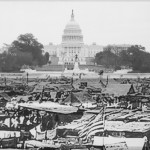Two Works by Lauren Bon
Encampment
November 10, 2011 (date created)
Gelatin Silver Print
Liminal camera, Chemical Photography (non-digital)
149.0 in (width) 45.0 in (height) 45.0 in (depth) (Artwork With container dimensions)
Bonus March, Washington DC
November 10, 2011 (date created)
Positive print
Liminal camera
The Bonus Army: The Struggle of Homeless and Jobless Veterans
By Chad Kautzer, Chief Curator
After WWI, veterans lobbied Congress to compensate them for some of their lost wages during the war, since many had lost homes and businesses while fighting. Some success came in 1924, although it took the form of government bonds, which veterans could cash out no earlier than 1945. This compromise was soon revisited with the onset of the Great Depression in 1929. Veterans, many more of whom were now jobless and homeless, lobbied to receive their “bonus” payment sooner, yet President Herbert Hoover adamantly opposed the idea.
In early 1932 tens of thousands of veterans and their families started making their way to Washington D.C., often hopping freight trains to get there. Calling themselves the “Bonus Expeditionary Force” or BEF, they occupied the space around the U.S. Capitol, erecting an enormous tent city with communal kitchens and even a people’s library. Under pressure from the veterans, legislation soon worked its way through the House, but was voted down by the Senate.
The veterans vowed to stay until new legislation passed, but Hoover called in the military to clear the encampment by force. The eviction was led by Gen. Douglas MacArthur and his two aids, Dwight D. Eisenhower and George S. Patton Jr.
With tanks, infantry, and the cavalry they cleared the veterans out, killing two and setting fire to the camps in the process. The actions of the veterans and the public outrage over the forceful eviction contributed to Hoover’s election loss later that year and the passing of the Servicemen’s Readjustment Act of 1944, or the G.I. Bill, for WWII veterans.

